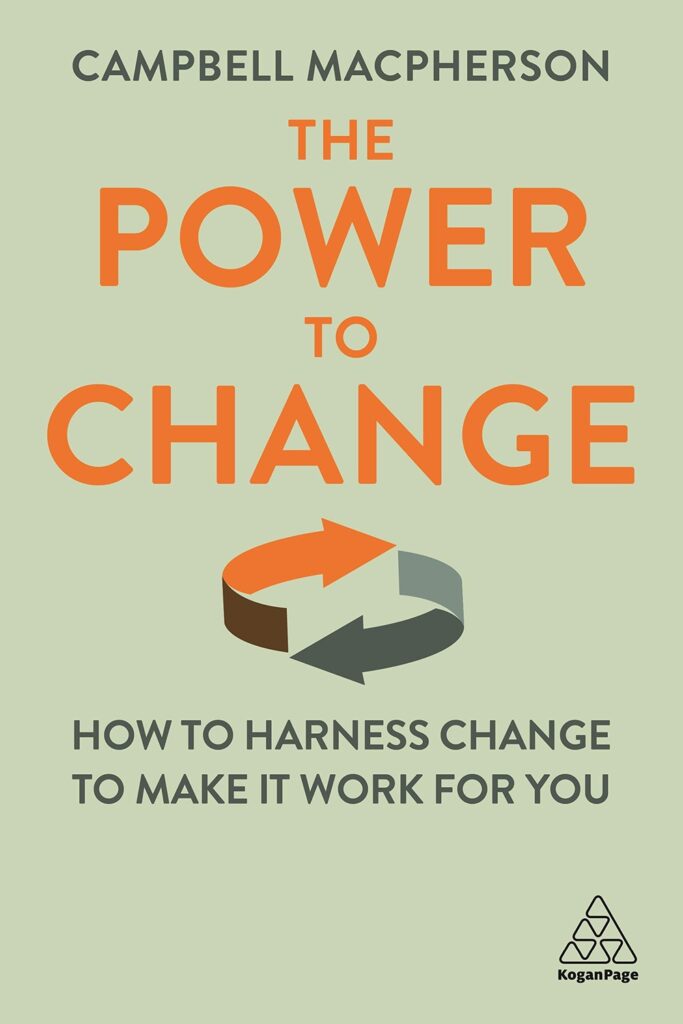Sharing my learnings from the book, The Power to Change by Campbell Macpherson
The Power to Change by Campbell Macpherson
The Power to Change does more than simply enable you just to cope with change – it gives you the tools and approaches to embrace and celebrate change. Written by award-winning author, Campbell Macpherson, this book provides a genuinely unique approach to celebrating change that will resonate with readers, no matter what sort of change they have to confront. The Power to Change gives readers the permission to feel emotional and have doubts and fears about change. It provides a range of techniques to put change into perspective, and allows readers to embrace and prosper from the challenges it presents.

- The only constant is change
- happiness and success are a matter of rolling with the changes the world throws your way and playing an active role in making change happen in your own life.
- four types of changes that can affect people’s lives or change matrix
- you could have a small change that’s externally imposed
- you could have a small change that’s self-initiated
- You could have a big change that’s externally imposed (burning platform change)
- you could have a big change that’s self-initiated (Quantum Leap Change)
- Reaction to a big change: Burning Platform Change Curve
- shock – typical 1st reaction
- denial
- anger
- fear
- depression – the rough of the curve
- curve starts bending upward – you come to understand and accept the change and you can move on to the next stage of your life
- Reaction to a big change: Quantum Leap
- excitement
- apprehension
- fear
- remorse
- rational optimism – climbing out of negative thoughts. You acknowledge that your situation is tough while at the same time optimistically reminding yourself that you can handle it
- genuine belief – belief in your ability to access
- embrace change
- Grieving is a necessary step in the healing process. You need to let yourself experience it. But you also need to prevent your grief from turning into self-blame or victimhood – two of the most common and harmful directions it can go in.
- It’s natural and normal to experience anger, misapprehension, and fear. Don’t try to repress or ignore them. That just makes them fester. To move forward, you’ve got to let them out and confront them in the open.
- How to escape victimhood
- acknowledge what you’re doing and realize the danger it poses.
- think of the victimhood trap as a triangle consisting of three people. First, there’s you, the Victim. Then there’s a second person, the Persecutor – someone you think has maliciously wronged you, Finally, there’s a third person, the Rescuer – someone who treats you like a victim and tries to comfort you. To get out of this triangle, reconceptualize the Persecutor as a Challenger and the Rescuer as a Coach.
- Identify your fear, so you can productively engage with it.
- three categories of fear:
- fear of failure – Rather than recoiling from this thought, confront it head-on. Mull it over. Lay out the probable consequences of failure. The worst-case scenario usually isn’t the end of the world, but it can seem that way as long as it remains a vague, unexamined figment of your imagination.
- fear of the unknown – use your fears as calls to action and clues about which steps you should take next, rather than reasons to give up.
- fear of blame – boils down to a fear of looking bad. it’s usually not a criticism; it’s a suggestion – an idea that’s meant to help you. See it as food for thought, rather than a threat.
- Respond to difficult emotions with openness, empathy, and a constructive attitude.
- Change is difficult. Even after you’ve made it past the low points of the change curve, you’re likely to face all sorts of other setbacks, challenges, and vexations before you reach the finish line. The more resilient you are, the more you’ll be able to weather these storms.
- Strengthen resilience by developing skills you’ve already learned about: managing your emotions and keeping ahold of your agency
- Believe in yourself; trust in your ability to overcome your obstacles. But don’t make things more difficult than they have to be. Create favorable conditions for success by changing your routines and environment to remove unnecessary challenges.
- Finally, don’t go it alone. Seek support.


Leave a Reply